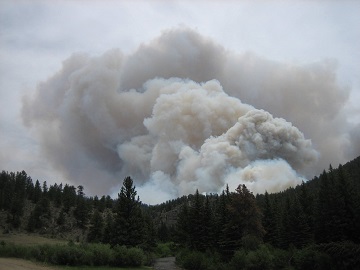Smoke

Smoke is a visible collection of a variety of solid, liquid, and gas particles left unburned during the combustion process.(Figure 1) It is possible for smoke to contain a large number of different chemicals and fumes, although visible smoke is mostly carbon or soot, tar, oils, and ash.[2] Because of its long list of components, smoke can contain a variety of different pollutants.
Smoke is created when a substance undergoes incomplete combustion. This simply means that there is not enough oxygen present when the material is burned to completely burn the fuel.[2] Instead of only carbon dioxide and water vapour being created, incomplete combustion can result in the production of soot, smoke, and ash. There are a variety of different sources of smoke, including:
- Fires (including wildfires, campfires, industrial fires, candles, fireplaces)
- Cooking devices (including wood-burning stoves or barbecues)
- Pest control activities (fumigation)
- Cigarettes
It is important to note that cigarette smoke is not completely the same as smoke from wildfires or other "conventional" fires as there are significantly more hazardous chemicals released from cigarettes.
Composition
Depending on the fuel that is being burned smoke can contain a wide variety of different components. Generally speaking, smoke always contains carbon, oils, and ash as they are what makes smoke visible. In a fire containing only wood, the smoke created contains volatile organic compounds that evaporate from the wood. The smoke also contains carbon (the main component of the wood), water vapour, and minerals that existed in the tree's cells such as calcium, potassium, and magnesium. Since these minerals do not burn, they make up the ash that is also produced. Any other substances, such as plastics, that are burned introduce hazardous chemicals to the smoke that depend strongly on the composition of the substance itself.
Smoke from cigarettes is much more complex in its composition, and often carcinogenic. It can include chemical components such as carbon monoxide, hydrogen cyanide, nitrogen oxides, formaldehyde, benzene, nicotine, and polycyclic aromatic hydrocarbons.[3]
Health Effects
Exposure to different types of smoke can result in different health effects. Mild exposure to smoke from forest fires or a campfire is generally not extraordinarily harmful to health, whereas exposure to secondhand smoke from a cigarette is more harmful. General smoke from wildfires and other wood-based fires can make it difficult to breathe, and exposure to it can aggravate existing heart and lung conditions. Symptoms of smoke exposure can cause sore eyes, tears, cough, and a runny nose. Lung problems can develop if exposure is high and excessive smoke exposure can result in death.[4]
Smoke from cigarettes is especially harmful as it contains over 7,000 chemicals; hundreds of which are toxic and around 70 can cause cancer.[5] Exposure to secondhand smoke can result in more frequent and severe asthma attacks, respiratory infections, ear infections, and an increased risk of developing heart disease and lung cancer. Exposure to cigarette smoke drastically increases stroke risk.
Exposure to smoke during a house fire is extremely dangerous, and smoke inhalation is the primary cause of death for victims of indoor fires. About 75% of home fire victims die as a result of smoke inhalation, not burns.[2] Depending on what is being burned, smoke that is generated during combustion can be toxic or irritating. For example, when plastics are burned they produce soot along with poisonous gases such as carbon monoxide and hydrogen chloride.[2] Any additional chemicals produced from burning different materials introduces a new set of health effects associated directly with exposure to that chemical.
For Further Reading
- Combustion
- Fire
- Oxygen
- Ash
- Soot
- Or explore a random page
References
- ↑ Wikimedia Commons. (September 12, 2015) Smoke Column [Online]. Available: https://upload.wikimedia.org/wikipedia/commons/b/bc/Smoke_column_-_High_Park_Wildfire.jpg
- ↑ 2.0 2.1 2.2 2.3 ScienceLearn. (September 12, 2015). What is smoke? [Online]. Available: http://sciencelearn.org.nz/Contexts/Fire/Science-Ideas-and-Concepts/What-is-smoke
- ↑ Cancer Control. (September 12, 2015). Cigarette Smoke Components and Disease [Online]. Available: http://cancercontrol.cancer.gov/brp/TCRB/monographs/7/m7_5.pdf
- ↑ Government of Manitoba. (September 12, 2015). Exposure to Smoke [Online]. Available: http://www.gov.mb.ca/health/publichealth/environmentalhealth/smoke.html
- ↑ CDC. (September 12, 2015). Secondhand Smoke Health Effects [Online]. Available: http://www.cdc.gov/tobacco/data_statistics/fact_sheets/secondhand_smoke/health_effects/

